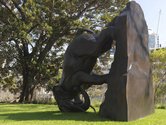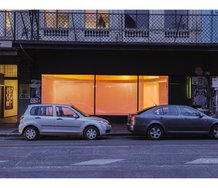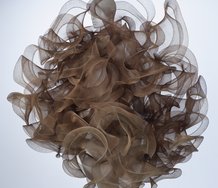Carmen Ansaldo – 10 April, 2015
To facilitate an open interpretation, Parekowhai has requested that there be no didactics provided, replacing them with a ‘wobble board’ of thumbnails of the featured works. This decision not only makes it easier for viewers to transfer their own interpretations onto works without the prescriptive gallery context/exegesis, but also enables the artist to resist the creation of a more traditional survey show where works are read chronologically.
Brisbane
Michael Parekowhai
The Promised Land
Curated by Maud Page
28 March - 21 June 2015
“It’s not the size of the object that matters. It’s the scale of the idea.”
Michael Parekowhai, interviewed by Kim Knight, 2011
Last weekend saw the Gallery of Modern Art in Brisbane, open the largest solo exhibition of New Zealand artist Michael Parekowhai to take place outside his home country. Spanning the entirety of GoMA’s Fairfax Gallery, The Promised Land comprises a total of 50 works encompassing 26 years of interdisciplinary practice. From such experience, Parekowhai has now developed a signature style through his consistent output of impressively scaled and flawlessly finished sculptural objects which elicit playful curiosity, humour and sincere wonder. At the same time these works exude other weightier layers of meaning involving formalist art historical properties and references, identities specific to the locale of New Zealand and the South Pacific, post-colonial theory, as well as experimentation with methods of audience interaction.
While there are no misgivings that The Promised Land signals a mammoth undertaking on behalf of Parekowhai and GoMA, the artist resists its categorisation as either a classical survey or retrospective. The Promised Land‘s curator, GoMA Deputy Director of Collections and Exhibitions Maud Page, commented to EyeContact that from the Gallery’s perspective, Parekowhai’s incredibly ambitious vision was not an undertaking GoMA could have embarked on with any other artist. The faith that the institution placed in Parekowhai has granted him conceptual free rein with The Promised Land, a trust that had been developed through a long-standing working relationship which began with his first participation in the 1999 Asian Pacific Triennial 3, and which grew through APT5 and Unnerved: The New Zealand Project in 2010. During this time Parekowhai has built a reputation as one of New Zealand’s most famous contemporary artists, confirmed by his extensive resume of international exhibitions, his representation of New Zealand in the 54th Venice Biennale and his Professorship at the Auckland University’s Elam School of Art.
Many of the works that were key in the establishing of Parekowhai’s practice are on display within The Promised Land. Of particular note is the inclusion of the GoMA acquisition, The Horn of Africa (2006), a massive mixed-media sculpture of a larger-than-life seal balancing a grand piano on its nose. Also worthy of mention is He Kōrero Pūrākau mo Te Awanui o Te Motu: story of a New Zealand river (2011), a fully-functional grand piano engraved with Māori designs of pītau spirals and manaia entities, finished entirely in a red high-gloss lacquer. The latter sculpture, ten years in the making, was Parekowhai’s contribution to the Venice Biennale in 2011; in The Promised Land it has been used to emphasise the end of the exhibition, although its music can be heard throughout the whole space.
The combination of Parekowhai’s bright colours, slick finish and provocatively bombastic subject matter produces works that exude a highly infectious energy. This inescapably leaves its impression on both those familiar with his practice and its art historical references - the most obvious example being the exhibition title itself, which directly references a 1948 painting of the same name by New Zealand’s most famous painter, Colin McCahon - right through to those who are discovering his practice for the first time.
A fitting example of this energy in action is one of the exhibition’s introductory (and Parekowhai’s most recent) works, The English Channel (2015). The English Channel is a realist, albeit larger-than-life, sculpture of the famous coloniser Captain James Cook. In contrast with more traditional sculptural depictions of Cook, here he is found sitting slumped over, adorned in full colonial regalia yet sporting a clearly dejected look on his face, with his legs hanging over the side of the plinth.
The sculpture is rendered entirely in stainless steel, and when this material consumes the historical subject of Cook, the result lends a fallible quality to both. The viewer is presented with an uneasy paradox of a material and subject matter that normally exude an unmovable authority. Here we see this status clearly contested, its values contradicted.
The English Channel sits within a true-to-size one-room house constructed specifically for The Promised Land. The house’s façade is rendered in 1970s salmon pink stucco, a dated yet familiar aesthetic of antipodean architecture. This structure evokes even more familiarity through its positioning, which ensures that the viewer - like someone visiting a friend’s house - enters through the back door. The structure of the home and the sculpture of Cook it houses, introduce the viewer to many conceptual threads available to be picked up and followed throughout the exhibition. All of these are anchored to the concept of the home and its plethora of relationships with the notion of a ‘promised land’.
To facilitate this open interpretation, Parekowhai has requested that there be no didactics provided, replacing them with a ‘wobble board’ of thumbnails of the featured works. This decision not only makes it easier for viewers to transfer their own interpretations onto works without the prescriptive gallery context/exegesis, but also enables the artist to resist the creation of a more traditional survey show where works are read chronologically as a neat narrative of progressing concepts and interests. Such an approach he did not see as suitable for the working rationales of his practice.
During its history, GoMA has been occasionally accused of demonstrating a preference for quantity over quality, opting for curatorial decisions geared to bring in audience numbers at the expense of work by more challenging topical artists relevant to the museum’s locale. The theme-park feel that can easily attach itself to a Parekowhai solo exhibition of this size is an issue difficult to avoid. However, The Promised Land communicates the intent behind the artist’s practice in a way that remains true to the purpose of both artist and institution. These works are nothing less than spectacular, precisely because of the principle outlined by Parekowhai in the quote that opens this review.
In her interview with EyeContact, Page recalls writing an introductory text starting with the question ‘What is the promised land?’ She said when she posed this question to the artist, Parekowhai felt it was more poignant to ask, ‘Where is the promised land?’
This re-phrasing sums up The Promised Land‘s objectives succinctly. The intent behind Parekowhai’s works speaks to the plethora of ways we collectively and individually conceptualise time, and how these conceptualisations can be triggered through the unlikely work of art. These works embody suspended seconds of real time, snippets of foggy memory recalled from an entirely different place, or even invocations of a historical moment we have only ever learnt about in books.
The emphasis on memory as an overriding concept has even led the artist to divide The Promised Land into three conceptual parts, the second of which has been named a ‘memory palace’. However, within this ‘palace’ there are numerous instances of this concept of memory struggling to stake its claim on the site of the art work, as the place where so many other concepts and meanings also emanate. This conceptual overload has the effect of confusing the feeling of some works and rendering the ‘memory palace’ as one layer of interpretation too many.
Add to this the dim lighting employed to create a ‘recollection’-like feel to the works, which sometimes seem poorly lit or, in some cases, sinister in a manner that would not have looked out of place within the same museum during the recent David Lynch survey. When so many of the artist’s works rely on their sleek finish and bright hues for impact, this gas lantern ‘palace’ installation does not present some items at their best.
This artist of Māori and European descent who invites audiences to engage with a shared historical subject matter - through the processes of play, humour and individual interpretation - is also one who attempts to breach the divide between what white art history has labelled ‘Indigenous art’ and the mainstream discourse it must sit outside of by default. Parekowhai has consistently resisted art historical contextualisation within a canon of Māori art, refusing to categorise his concerns as exclusively Indigenous.
Instead, he irreverently plays with interpretations of colonial history and its many readings through an unashamedly provocative reworking of its icons, clashing with aesthetics that remain central to ‘the history wars’ and its players.
Parekowhai’s unwavering determination to utilise the historical currency of such icons for light-hearted ends has given rise to a practice that actively attempts to locate a shared experience, a common resonance between individuals who share geographic locales, even if they do not share, historically, a cultural heritage. In this way, his refusal to be categorised purely within the boundaries of Indigenous revisionism becomes essential for his practice to function in the way he intends; so it can pinpoint precisely what is evocative about these icons, what resonates, and what provides joy and happiness over difference.
Here humour is not just utilised as the great leveller, it is also a tactic able to create new possibilities from old, discovering their real potential. The fact that Parekowhai uses his practice to extend over these historical divides is courageous, because it is not the assumed responsibility of the artist - as an individual who has adversely experienced the impact of said history - to undertake this bridging process. The fact he does so regardless, through a practice that is aesthetically flawless in its execution, disarming in its humour and irreverent in its curiosity, is the true strength and real success of The Promised Land.
Carmen Ansaldo is a freelance art writer from Brisbane who is based in Melbourne. She was flown to Brisbane to attend the opening of The Promised Land by the Queensland Art Gallery/Gallery of Modern Art.
Recent Comments
Ralph Paine
III. In dialectical contrast, Parekowhai lives and breathes postmodernity. His concerns are formed and sustained by what we might call ...
Ralph Paine
II. McCahon lived and breathed modernity. He was motivated by a sense of art’s futurity—motivated, that is, by how his ...
Ralph Paine
I. Somewhat naive simply to accept Parekowhai’s assertion “no didactics.” I’m assuming no curatorial wall texts here, but whence all ...








 Advertising in this column
Advertising in this column Two Rooms presents a program of residencies and projects
Two Rooms presents a program of residencies and projects



This Discussion has 3 comments.
Comment
Ralph Paine, 4:19 p.m. 13 April, 2015 #
I.
Somewhat naive simply to accept Parekowhai’s assertion “no didactics.” I’m assuming no curatorial wall texts here, but whence all this authoritative information about the artist and his ideas, the exhibition and the career? In fact, why class room chairs and Cuisenaire rods? Why these scholarly-type titles for works and spaces? And are not “thumb nails” a kind of teaching aid; the exhibition itself a history lesson of sorts? But more importantly, why the artist’s anti-didactics stance at all, when clearly he is steeped in didactics?
However we may choose to answer these questions, what’s interesting in the first instance is how they throw a dialectical play of light on the actual meta-lesson being delivered here: when “The Promised Land” is one’s overarching title—after McCahon indeed!— unquestionably the ante’s been upped.
Ralph Paine, 4:19 p.m. 13 April, 2015 #
II.
McCahon lived and breathed modernity. He was motivated by a sense of art’s futurity—motivated, that is, by how his singular works might reveal in the here and now what he perceived to be the coming and promised forms of collective life. In a religious sense, this is eschatology—the all too familiar notion of McCahon-as-prophet. But it is also a kind of politics, the politics of a people yet-to-come. Thus his art presented itself as an open question—or as a series of open questions—about fresh possibilities for art, certainly, but also about what it might mean to be a people. Now, the best way of reposing these questions today—on McCahon’s behalf as it were—would be to ask: what is the relationship between a people and a place; between a set of communities and a landscape? And do a people, through its very processes of political formation and constitution, in fact create a unique concept of place? If before I linked McCahon’s politics to an ultimate concern for the future, we note that this concern arose from actions, thought processes, perceptions, and emotions clearly linked to the geological, atmospheric, and oceanic: McCahon was thinking with the earth. And rather than deny “didactics,” he conjured up his art as a superior form of “teaching aid.”
Ralph Paine, 4:20 p.m. 13 April, 2015 #
III.
In dialectical contrast, Parekowhai lives and breathes postmodernity. His concerns are formed and sustained by what we might call the rise and rise of the Baudrillard-effect in art, that is to say, by simulacra and shiny surface, commodity fetishism and installationism (a condition of seamlessness within the artist/curator/institution nexus), spectacle and the waning of the “real”, “depthlessness” (Jameson) and presentism. Regarding the later, postmodernity is said to be that historical period when: futurity collapses into a set of very short-term “futures”(both social and economic); the past or memory is reduced to endless pastiche and kitsch; and, an eternally recurring present dominates our sense of time (“groundhog day”). As concerns a people (any people whosoever) and its sense of place (any place whatsoever), postmodernity has transformed all space into real estate, and the earth itself into a globalised marketplace. Parekowhai’s history lesson is thus a profoundly post-historical one; his “promised land” a dreamscape of nowheresville. No wonder then that Captain Cook seems so depressed and apathetic. Yet perhaps it’s the view out what seem big gallery windows to the pine forest beyond which offers at least an allegorical glimpse of some way out of our postmodern present. Not real estate potential—rather the shimmering sense of a yet to be realised depth in the shadows. But no, an electronic surface effect is all that’s there: the Screen.
Participate
Register to Participate.
Sign in
Sign in to an existing account.